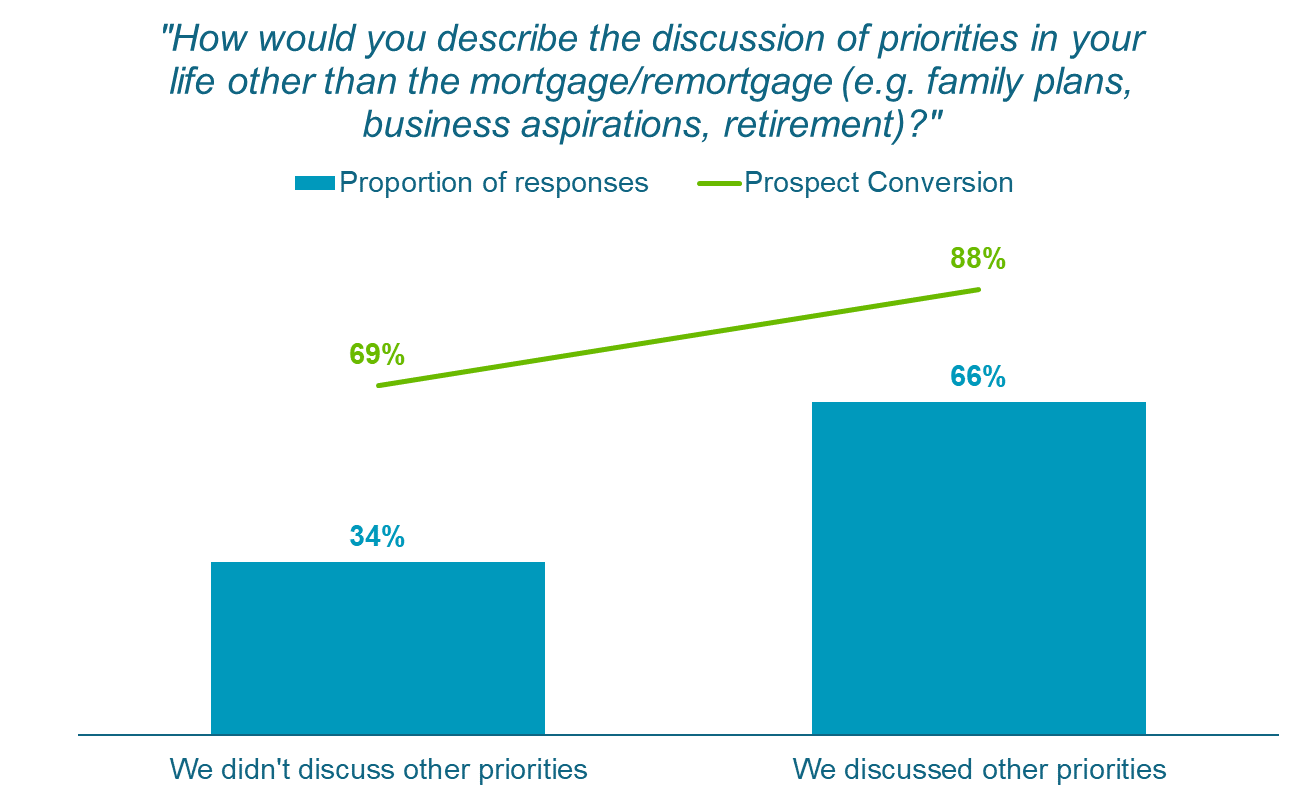Broader Priorities Discussion
Broader Priorities Discussion is a Driver of Elevation Goal 1: Making great first impressions, increasing conversion
Data based on responses to the following question, asked in the Verified Client review form
"How would you describe the discussion of priorities in your life other than the mortgage/remortgage (e.g. family plans, business aspirations, retirement)?"
Possible responses
We didn’t discuss other priorities
We discussed other priorities as part of the necessary mortgage process
We discussed other priorities in depth as part of the necessary mortgage process
We discussed other priorities in depth and it felt like the adviser took a genuine interest
Broader Priorities Discussion Score
Proportion of respondents answering “We discussed other priorities as part of the necessary mortgage process”, “We discussed other priorities in depth as part of the necessary mortgage process”, or “We discussed other priorities in depth and it felt like the adviser took a genuine interest”
Relationship between Broader Priorities Discussion and Conversion Rate
The relationship between Broader Priorities Discussion and Conversion Rate is statistically significant
Why do we ask about Broader Priorities Discussion?
Discussion of broader priorities captures the nature of the discussion between the client and the adviser, and is an indicator of how well the client feels the adviser understands their needs. This arose as a key driver of conversion through our qualitative research with firm management teams, advisers and clients.
We confirmed this relationship quantitatively through our review forms.
How to improve your score:
Start with your client, not the mortgage
Establish Rapport. Rapport extends beyond small-talk. Finding genuine common ground to talk about which connects you to your client.
Beware starting your conversation with money. This can be an immediate turn off for your prospective clients and risks a superficial conversation preventing you from understanding your client’s real drivers & motivation.
Watch Your Language. Be mindful of the questions you ask and the language you use. For example, exchange “how can I help” for “what are you looking to achieve”. This subtle change in question moves the focus away from what you can do for them and onto what they want to accomplish.
Active listening. Being conscious of your behaviour and body language when your client is talking. Active listening is a great way to show your client that you’re interested in what they have to say.
Look at the broader context
Understanding drivers. It can be easy to take things at face value but take the time to dig a bit deeper and find out why your client is buying that particular house or wanting to look at a 10-year fix. Chances are there is a broader context to why they want that house. Challenging your clients and asking leading questions to understand their broader context will help exceed your client expectations.
Ask about future plans. Whilst your client’s primary concern is probably arranging this mortgage, it could be that their future plans influence the best type of mortgage for them. Spend time finding out what they see in their future.
Focus on goals. Focus your conversation on personal goals, jobs and family over talking properties as this will often reveal a good deal of information about your client that wouldn’t come from structured questioning on a fact find.
Validate understanding
Reinforce & Validate. Check your understanding regularly with your client. Say “So let me just check I’ve understood that correctly” and then repeat back what your client has just told you. This reinforces that you are interested in them as you want to ensure you get everything right.
By focusing on your client, rather than a product, you build rapport and deepen trust. This increases the chances of an ongoing relationship and your client recommending you to others. You also get a much broader picture of their circumstances, which may have an impact on the advice you give and help you deliver good outcomes for your clients in line with the Consumer Duty.

